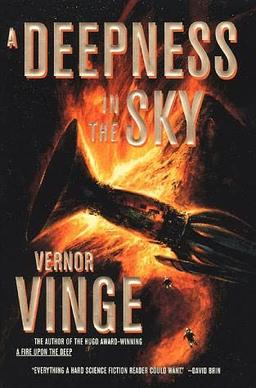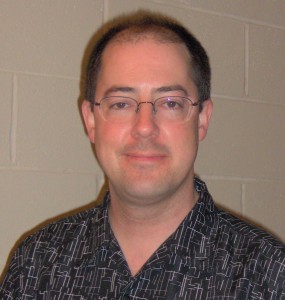Related Research Articles

A mobile device or handheld computer is a computer small enough to hold and operate in the hand. Mobile devices are typically battery-powered and possess a flat-panel display and one or more built-in input devices, such as a touchscreen or keypad. Modern mobile devices often place emphasis on wireless networking, to both the Internet and to other devices in their vicinity, such as headsets or in-car entertainment systems, via Wi-Fi, Bluetooth, cellular networks, or near-field communication.

A Deepness in the Sky is a science fiction novel by American writer Vernor Vinge. Published in 1999, the novel is a loose prequel to his earlier novel A Fire Upon the Deep (1992). The title is coined by one of the story's main characters in a debate, in a reference to the hibernating habits of his species and to the vastness of space.
Wireless sensor networks (WSNs) refer to networks of spatially dispersed and dedicated sensors that monitor and record the physical conditions of the environment and forward the collected data to a central location. WSNs can measure environmental conditions such as temperature, sound, pollution levels, humidity and wind.
Energy harvesting (EH) – also known as power harvesting,energy scavenging, or ambient power – is the process by which energy is derived from external sources, then stored for use by small, wireless autonomous devices, like those used in wearable electronics, condition monitoring, and wireless sensor networks.
TSMP, an acronym for Time Synchronized Mesh Protocol, was developed by Dust Networks as a communications protocol for self-organizing networks of wireless devices called motes. TSMP devices stay synchronized to each other and communicate in time-slots, similar to other TDM systems. Such deterministic communication allows the devices to stay extremely low power, as the radios only turn on for the periods of scheduled communication. The protocol is designed to operate very reliably in a noisy environment. It uses channel hopping to avoid interference -- the packets between TSMP devices get sent on different radio channels depending on time of transmission. TSMP distinguishes itself from other time-slotted mesh-based protocols, in that time-slot timing is maintained continuously and enables a network to duty-cycle on a transmitter-receiver pair-wise basis, as opposed to putting the entire network to sleep for extended periods of time.

A sensor node, consists of an individual node from a sensor network that is capable of performing a desired action such as gathering, processing or communicating information with other connected nodes in a network.
The Internet of things (IoT) describes devices with sensors, processing ability, software and other technologies that connect and exchange data with other devices and systems over the Internet or other communications networks. The Internet of things encompasses electronics, communication, and computer science engineering. "Internet of things" has been considered a misnomer because devices do not need to be connected to the public internet; they only need to be connected to a network and be individually addressable.

Kristofer S. J. Pister is a professor of electrical engineering and computer sciences at University of California, Berkeley and the founder and CTO of Dust Networks. He is known for his academic work on Microelectromechanical systems (MEMS), their simulation, his work on Smartdust, and his membership in the JASON Defense Advisory Group. He is the son of former Berkeley Dean of Engineering and former UC Chancellor Karl Pister.

Mike A. Horton is an American engineer and founder of a company producing sensor technology and sensor-based systems.
Cyber-Physical Systems (CPS) are integrations of computation with physical processes. In cyber-physical systems, physical and software components are deeply intertwined, able to operate on different spatial and temporal scales, exhibit multiple and distinct behavioral modalities, and interact with each other in ways that change with context. CPS involves transdisciplinary approaches, merging theory of cybernetics, mechatronics, design and process science. The process control is often referred to as embedded systems. In embedded systems, the emphasis tends to be more on the computational elements, and less on an intense link between the computational and physical elements. CPS is also similar to the Internet of Things (IoT), sharing the same basic architecture; nevertheless, CPS presents a higher combination and coordination between physical and computational elements.
The nanomorphic cell is a conception of an atomic-level, integrated, self-sustaining microsystem with five main functions: internal energy supply, sensing, actuation, computation and communication. Atomic level integration provides the ultimate functionality per unit volume for microsystems. The nanomorphic cell abstraction allows one to analyze the fundamental limits of attainable performance for nanoscale systems in much the same way that the Turing Machine and the Carnot Engine support such limit studies for information processing and heat engines respectively.
Dust Networks, Inc. is an American company that specializes in the design and manufacture of wireless sensor networks for industrial applications including process monitoring, condition monitoring, asset management, environment, health and safety (EHS) monitoring, and power management. They were acquired by Linear Technology, Inc in December 2011, which in turn was acquired by Analog Devices, Inc. in 2017. The Dust Networks product team operates in the IoT Networking Platforms group of Analog Devices.
David Ethan Culler is a computer scientist and former chair of the Department of Electrical Engineering and Computer Sciences at the University of California, Berkeley. He is a principal investigator in the Software Defined Buildings (SDB) project at the EECS Department at Berkeley and the faculty director of the i4Energy Center. His research addresses networks of small, embedded wireless devices, planetary-scale internet services, parallel computer architecture, parallel programming languages, and high performance communication. This includes TinyOS, Berkeley Motes, PlanetLab, Networks of Workstations (NOW), Internet services, Active Message, Split-C, and the Threaded Abstract Machine (TAM).
OSIAN, or Open Source IPv6 Automation Network, is a free and open-source implementation of IPv6 networking for wireless sensor networks (WSNs). OSIAN extends TinyOS, which started as a collaboration between the University of California, Berkeley in co-operation with Intel Research and Crossbow Technology, and has since grown to be an international consortium, the TinyOS Alliance. OSIAN brings direct Internet-connectivity to smartdust technology.
The Illinois Structural Health Monitoring Project (ISHMP) is a structural health monitoring project devoted to researching and developing hardware and software systems to be used for distributed real-time monitoring of civil infrastructure. The project focuses on monitoring bridges, and aims to reduce the cost and installation effort of structural health monitoring equipment. It was founded in 2002 by Professor Bill F. Spencer and Professor Gul Agha of the University of Illinois at Urbana–Champaign.

OpenWSN is a project created at the University of California Berkeley and extended at the INRIA and at the Open University of Catalonia (UOC) which aims to build an open standard-based and open source implementation of a complete constrained network protocol stack for wireless sensor networks and Internet of Things. The root of OpenWSN is a deterministic MAC layer implementing the IEEE 802.15.4e TSCH based on the concept of Time Slotted Channel Hopping (TSCH). Above the MAC layer, the Low Power Lossy Network stack is based on IETF standards including the IETF 6TiSCH management and adaptation layer. The stack is complemented by an implementation of 6LoWPAN, RPL in non-storing mode, UDP and CoAP, enabling access to devices running the stack from the native IPv6 through open standards.
Time Slotted Channel Hopping or Time Synchronized Channel Hopping (TSCH) is a channel access method for shared-medium networks.

Subsea Internet of Things (SIoT) is a network of smart, wireless sensors and smart devices configured to provide actionable operational intelligence such as performance, condition and diagnostic information. It is coined from the term The Internet of Things (IoT). Unlike IoT, SIoT focuses on subsea communication through the water and the water-air boundary. SIoT systems are based around smart, wireless devices incorporating Seatooth radio and Seatooth Hybrid technologies. SIoT systems incorporate standard sensors including temperature, pressure, flow, vibration, corrosion and video. Processed information is shared among nearby wireless sensor nodes. SIoT systems are used for environmental monitoring, oil & gas production control and optimisation and subsea asset integrity management. Some features of IoT's share similar characteristics to cloud computing. There is also a recent increase of interest looking at the integration of IoT and cloud computing. Subsea cloud computing is an architecture design to provide an efficient means of SIoT systems to manage large data sets. It is an adaption of cloud computing frameworks to meet the needs of the underwater environment. Similarly to fog computing or edge computing, critical focus remains at the edge. Algorithms are used to interrogate the data set for information which is used to optimise production.
Neural dust is a hypothetical class of nanometer-sized devices operated as wirelessly powered nerve sensors; it is a type of brain–computer interface. The sensors may be used to study, monitor, or control the nerves and muscles and to remotely monitor neural activity. In practice, a medical treatment could introduce thousands of neural dust devices into human brains. The term is derived from "smart dust", as the sensors used as neural dust may also be defined by this concept.
References
- ↑ More than Meets the eye. PC Mag. Mar 12, 2002. Page 30.
- ↑ Rosenthal, Marshal M. "Gamebits: Digital Tricks". Games . Issue 160 (Vol 24, #3). Pg.6. May 2000.
- ↑ "Smart Dust: BAA97-43 Proposal Abstract, POC: Kristofer S.J. Pister" (PDF). berkeley.edu. Retrieved 19 April 2018.
- ↑ "An autonomous 16 mm/sup 3/ solar-powered node for distributed wireless sensor networks - IEEE Conference Publication". doi:10.1109/ICSENS.2002.1037346. S2CID 17152548.
{{cite journal}}: Cite journal requires|journal=(help) - ↑ "CiteSeerX". psu.edu. Retrieved 19 April 2018.
- ↑ Makin, Simon (August 8, 2016). ""Neural Dust" Could Enable a Fitbit for the Nervous System". Scientific American. Retrieved 19 April 2018.
- ↑ "Smart Dust for Space Exploration". Archived from the original on 2017-06-30. Retrieved 2010-01-28.
- ↑ "2003 Gartner Hype Cycle on emerging technologies". Gartner. Retrieved 20 August 2016.
- ↑ "2013 Gartner Hype Cycle on emerging technologies". Gartner. Archived from the original on August 19, 2013. Retrieved 14 September 2015.
- ↑ Iyer, Vikram; Gaensbauer, Hans; Daniel, Thomas L.; Gollakota, Shyamnath (2022-03-17). "Wind dispersal of battery-free wireless devices". Nature. 603 (7901): 427–433. Bibcode:2022Natur.603..427I. doi:10.1038/s41586-021-04363-9. ISSN 0028-0836. PMID 35296847. S2CID 247499662.
